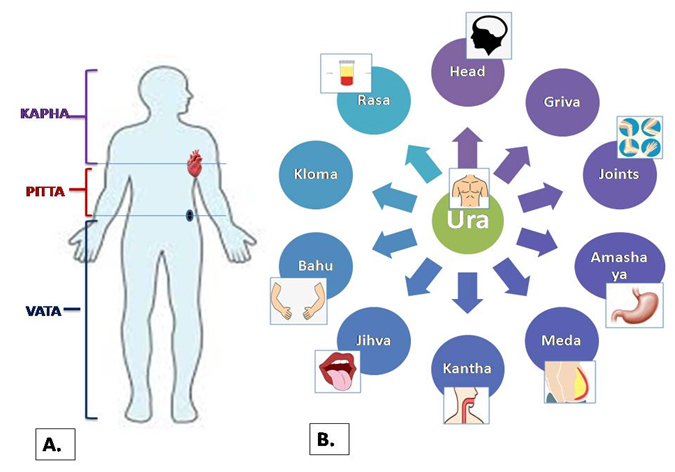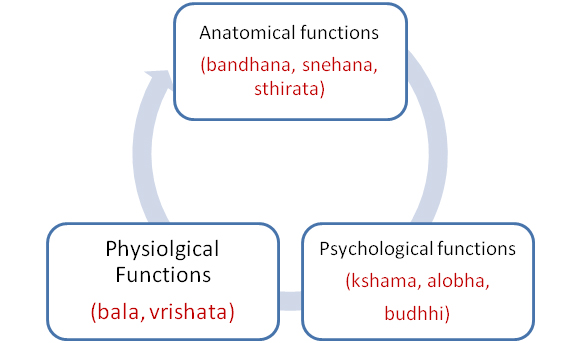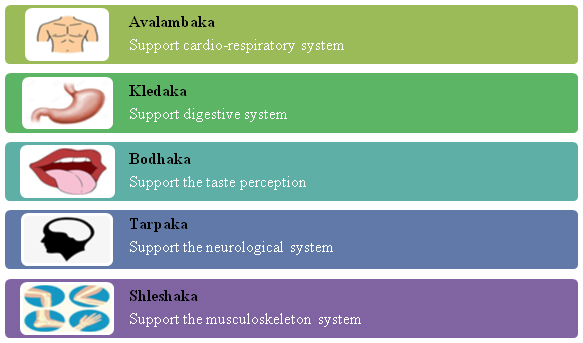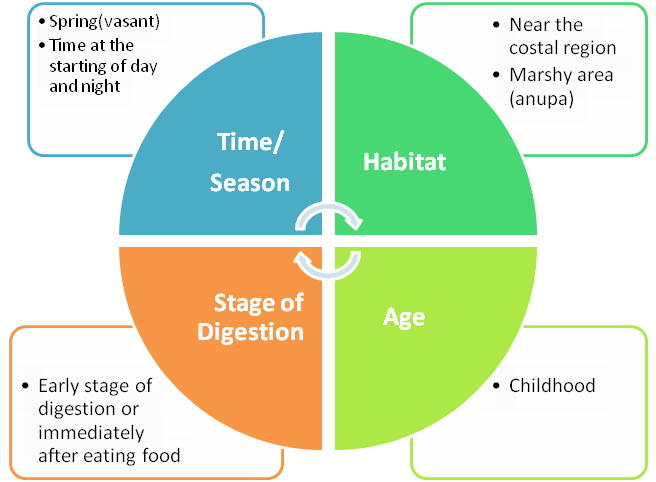Kapha dosha

| Section/Chapter/topic | Concepts/Dosha/Kapha Dosha |
|---|---|
| Authors |
Bhojani M. K. 1, Tanwar Ankur Kumar 1 |
| Reviewer | Basisht G.2, |
| Editor | Deole Y.S.3 |
| Affiliations |
1 Department of Sharir Kriya, All India Institute of Ayurveda, New Delhi, India 2 Rheumatologist, Orlando, Florida, U.S.A. 3Department of Kayachikitsa, G.J.Patel Institute of Ayurvedic Studies and Research, New Vallabh Vidyanagar, Gujarat, India |
| Correspondence emails |
meera.samhita@aiia.gov.in, carakasamhita@gmail.com |
| Publisher | Charak Samhita Research, Training and Development Centre, I.T.R.A., Jamnagar, India |
| Date of publication: | December 16, 2022 |
| DOI | 10.47468/CSNE.2022.e01.s09.123 |
Etymology and derivation
Synonyms:[3][4]
In abnormal states- Papma, mala[Cha. Sa. Sutra Sthana 17/117]
Various aspects:
Bhautika composition
Kapha dosha and triguna

Sites of kapha
- Chest(Ura)[Cha.Sa. Sutra Sthana 20/9] [Su. Sa.SutraSthana 21/7][3][A.S. Sutra Sthana 20/3][5][A.Hr. Sutra Sthana 12/3][8] [K.S. Sutra Sthana 27/11][9]
- Head (shira)[Cha.Sa. Sutra Sthana 20/9] [Su. Sa.SutraSthana 21/7][3][A.S. Sutra Sthana 20/3][5][A.Hr. Sutra Sthana 12/3][8]
- Neck region(griva)[Cha.Sa. Sutra Sthana 20/9][K.S. Sutra Sthana 27/11][9]
- Joints (parva or sandhi)[Cha.Sa. Sutra Sthana 20/9] [Su. Sa.SutraSthana 21/7][3] [A.S. Sutra Sthana 20/3][5][A.Hr. Sutra Sthana 12/3][8][K.S. Sutra Sthana 27/11][9]
- Stomach(amashaya)[Cha.Sa. Sutra Sthana 20/9] [A.S. Sutra Sthana 20/3][5] [A.Hr. Sutra Sthana 12/3][8]
- Fat (meda)[Cha.Sa. Sutra Sthana 20/9] [A.S. Sutra Sthana 20/3][5] [A.Hr. Sutra Sthana 12/3][8] [K.S. Sutra Sthana 27/11][9]
- Throat(kantha) [Su. Sa.SutraSthana 21/7][3] [A.S. Sutra Sthana 20/3][5][A.Hr. Sutra Sthana 12/3][8]
- Organ controlling water uptake and loss(kloma) [A.S. Sutra Sthana 20/3][5] [A.Hr. Sutra Sthana 12/3][8]
- Nutrient body fluid or plasma (rasa)[A.S. Sutra Sthana 20/3][5][A.Hr. Sutra Sthana 12/3][8]
- Nose (ghrana) [A.S. Sutra Sthana 20/3][5] [A.Hr. Sutra Sthana 12/3][8]
- Tongue(jihva or rasana)[Su. Sa.SutraSthana 21/7][3][A.S. Sutra Sthana 20/3][5] [A.Hr. Sutra Sthana 12/3][8]
- Arms(bahu) [K.S. Sutra Sthana 27/11][9]
Among all these sites, chest region (ura) is the prime site of kapha dosha.[Cha.Sa. Sutra Sthana 20/9][A.S. Sutra Sthana 20/3][5] [A.Hr. Sutra Sthana 12/3][8] [Arunadatta on A.Hr. Sutra Sthana 12/3][8] Kapha doshais predominately present in stomach(amashaya). [Su. Sa.Sutra Sthana 21/6][3] Chakrapani precisely explains the location of kapha as upper part of amashaya(stomach). [Chakrapani on Cha.Sa. Sutra Sthana 20/8]

Attributes:
- Heaviness(guru or gaurava)[Cha.Sa. Sutra Sthana 1/61][Cha.Sa. Sutra Sthana 20/18] [Cha.Sa. Vimana Sthana 8/96] [Su. Sa.Sutra Sthana 21/15][3] [A.Hr. Sutra Sthana 1/12][8] [K.S. Sutra Sthana 27/44][9] [Sh.Sa.Pratham Khand 5/34][6]
- Coldness(shita)[Cha.Sa. Sutra Sthana 1/61] [Cha.Sa. Sutra Sthana 20/18] [Cha.Sa. Vimana Sthana 8/96][Su. Sa.SutraSthana 21/15][3][Sh.Sa.Pratham Khand 5/34][6] [A.Hr. Sutra Sthana 1/12][8][K.S. Sutra Sthana 27/44][9]
- Softness (mridu)[Cha.Sa. Sutra Sthana 1/61] [Cha.Sa. Vimana Sthana 8/96]
- Unctuousness (snigdha) [Cha.Sa. Sutra Sthana 1/61] [Cha.Sa. Sutra Sthana 20/18] [Cha.Sa. Vimana Sthana 8/96] [Su. Sa.SutraSthana 21/15][3][A.Hr. Sutra Sthana 1/12][8][K.S. Sutra Sthana 27/44][9] [Sha.Sa.Pratham Khand 5/34][6]
- Sweet (madhura)[Cha.Sa. Sutra Sthana 1/61] [Cha.Sa. Sutra Sthana 20/18] [Cha.Sa. Vimana Sthana 8/96] [Su. Sa.Sutra Sthana 21/15][3] [Sha.Sa.Pratham Khand 5/34][6] [K.S. Sutra Sthana 27/44][9]
- Firmness/stability (sthira)[Cha.Sa. Sutra Sthana 1/61][A.Hr. Sutra Sthana 1/12][8]
- Sliminess (picchila)[Cha.Sa. Sutra Sthana 1/61][Su. Sa.SutraSthana 21/15][3] [Sha.Sa.Pratham Khand 5/34][6]
- Whitish(shaukalya or shweta) [Cha.Sa. Sutra Sthana 20/18] [Cha.Sa. Vimana Sthana 8/97][Su. Sa.SutraSthana 21/15][3][Sha.Sa.Pratham Khand 5/34][6] [K.S. Sutra Sthana 27/44][9]
- Mouldable (mrutsana)[Cha.Sa. Sutra Sthana 20/18] [A.Hr. Sutra Sthana 1/12][8]
- Smoothness (slakshana) [Cha.Sa. Vimana Sthana 8/96] [A.Hr. Sutra Sthana 1/12][8]
- Mobile(sara) [Cha.Sa. Vimana Sthana 8/96]
- Compact(sandra) [Cha.Sa. Vimana Sthana 8/96]
- Slowness(manda) [Cha.Sa. Vimana Sthana 8/96] [A.Hr. Sutra Sthana 1/12][8]
- Stable (stimita) [Cha.Sa. Vimana Sthana 8/96]
- Viscous(vijjala) [Cha.Sa. Vimana Sthana 8/96]
- Transparent(accha) [Cha.Sa. Vimana Sthana 8/96]
Functions of kapha
- Provides and maintains unctuousness to the body (snehana)
- Maintains the anatomical integrity of various cells, tissue, and organ with each other, as well as provides support/ Maintain the integrity of joints(bandhana)
- Maintain firmness and steadiness(sthirata or dardhyata)
- Provides weight to various structures and organs (gauravata)
- Maintains reproductive health(vrishta)
- Provides physical and mental strength(bala)
- Maintains the quality of forgiveness(kshama)
- Maintains the quality of patience(dhriti)
- Maintains the quality of greedlessness(alobha)
- Growth of the body(upachaya)
- Fortitude
- Knowledge(jnana)
- Intelligence (buddhi)

Acharya Vagbhatawas the first to describe five types of kapha with names. [A.Hr. Sutra Sthana 12/15-18][8] Five particular functions of kapha are as below: [Su.Sa. Sutra Sthana 15/4][3] [Dalhana on Su.Sa. Sutra Sthana 15/4][3]
- Maintains the structural integrity of joints(sandhi samshleshana)
- Maintains the unctuousness (snehana)
- Helps in the healing process(ropana)
- Provides nutrition to the whole body(purana)
- Provides strength (bala)
Classification
Five types:
| S.No. | Type of kapha | Location | Function |
|---|---|---|---|
| 01. | Avalambaka [Code:SAT-B.415][1] |
Chest(ura) |
|
| 02. | Kledaka [Code:SAT-B.416][1] |
Stomach(amashaya) |
|
| 03. | Bodhaka [Code:SAT-B.417][1] |
Root of tongue(jihvamula) Throat(kantha) |
|
| 04. | Tarpaka [Code:SAT-B.418][1] |
Head (shira) |
|
| 05. | Shleshaka [Code:SAT-B.419][1] |
Joints (sandhi) |
|

Kapha dominant constitution (prakriti)
- Unctuous and smooth organs
- Pleasing personality and fair in complexion
- Compact body appearance
- Slow digestive process
- Slow in physical and mental movements
- Less perspiration, thirst and hunger
- Intelligent
- Thick and dense hair
- Obedient to teachers
Lokapurusha samanya
Factors responsible for abnormal states of kapha
Natural factors:
- Season(ritu): Kapha undergoes accumulation in winter(hemant and shishira), gets vitiated in during spring(vasanta) and subsides to normal during summer(grishma).
- Various stages of digestion of food: Kaphagetsincreasedduring thefirst stage of digestion or immediately after eating food(bhuktamatra).
- Biological rhythm of day and night: Kaphais increased in the morning (purvahe) and evening (purvaratre or pradoshe).
- Habitat(desha): Marshy area (anupa).
- Age (vaya): In childhood, kapha is dominant as compared to other dosha.

Acquired factors:
- Diet(dravya) and properties of diet: Food with sweet(madhura), sour(amla)and salt(lavana) taste, heavy-to-digest food, slimy, unctuous food articles and excessive intake of water cause kapha vitiation.
- Lifestyle and other activities: Daytime sleep (diwaswapana), lack of exercise(avyayama), drinking water at night(nishaambupana), mixing wholesome and unwholesome together (samashana) and over eating before digestion of previous meals(adhyashana), etc. [Su.Sa. Sutra Sthana 21/23-24][3]
- Emotional and behavior factors: pleasure(harsha).
Clinical aspects
Preventive aspect:
Stages of dosha:
13.2.1Hyperfunctioning of kapha(vridhilakshana):
- Whitish coloration of skin(shaukalaya)
- A feeling of coldness (shaityam)
- Firmness and stiffness(sthairyam)
- Heaviness in body(gauravam)
- Depression (avasada)
- Drowsiness(tandra)
- Sleepiness(nidra or atinidrata)
- Lack of firmness in joints(sandhivishlesha)
- Low digestive capacity (agnisadana)
- Salivation(praseka)
- Laziness(alasya)
- Flaccidity (slathangatvam or angasada)
- Dyspnea (shwasa)
- Cough(kasa)
- Obesity(sthaulya)
- Blockage of natural passages(srotapidana)
- Syncope (murchha)
- Nausea (hrillasa)
Hypo functioning of kapha (kshayalakshana):
- Dryness (rukshata)
- Burning sensation in the body(antardaha)
- Emptiness in all sites of kaphaespecially stomach(amashyaitrashleshmashyashunyta)
- Flaccid joints(sandhi shaithilya)
- Thirst (trishna)
- Weakness (daurbalya)
- Loss of sleep (prajagarana or anidra)
- Giddiness (bhrama)
- Twisting pain(udveshtana)
- Body aches (angamarda)
- A feeling of burning skin(parishosha)
- Pricking pain(toda)
- Tremors (vepana)
- Burning sensation(daha)
- A feeling of cracking or breaking pain(sphotana)
- Feeling of smoke(dhumayana)
- Palpitation (hridayadrava)
Diagnosis:
Forty types of diseases due to an imbalance of kaphadosha(kaphananatmajavyadhi) occur, as below [Cha.Sa. SutraSthana 20/17] [K.S. Sutra Sthana 27/42-43][9] (Table 02)
| Contentment(trupti) | Drowsiness (tandra) | Excess sleep (nidradhikya) | Rigidity/stiffness (staimitya) |
| Heaviness in body(gurugatrata) | Lassitude (alasya) | Sweet taste in mouth (mukhamadhurya) | Salivation (mukhastrava) |
| Expectoration of mucous(shleshmodgirana) | Excess accumulation of waste products (maladhikya) | Loss of strength (balasaka) | Indigestion (apakti) |
| Adherence or coatingaround heart(hridayopalepa) | Adherence or coating in throat (kanthopalepa) | Adherence of waste in blood vessels/ atherosclerosis (dhamanipratichaya) | Goiter (galaganda) |
| Morbid obesity (atisthaulya) | Decreased digestive power (shitagnita) | Urticarial rashes (udarda) | Pale look (shvetavabhashata) |
Diagnostic and assessment tools:
Subjective and objective methods which may be used to assess the normalfunctioning of kapha are:
- Test for assessment for muscular strength and endurance likedynamometry[11] and 6 minute walk test[12], etc.
- Cardio- Pulmonary exercise tests[13].
- Lipid profile[14], adiponectin[15] for assessment of meda.
- Dual-energy X-ray absorptiometry[16]
- Bioelectrical impedance devices to measure body fat percent (BF%), fat mass (FM), and fat-free mass (FFM).[17]
- Electro-gustometry[18]
- CSF examination[19]
- Lung capacity and volume assessment[20][21].
- Spirometry[22]
Treatment
Honey (madhu) and oil(tail) is helpful for the vitiated kapha dosha. [Cha. Sa. Sutra Sthana 25/40]
The herbs with pungent, bitter, astringent, hot, and penetrating qualities are used in single or combination along with therapies like swedana (sudation therapy), nasya (nasal therapy), exercise, etc. These are helpful in the treatment of kapha disorders. [Cha.Sa. Sutra Sthana 20/19] [K.S. Sutra Sthana 27/46][9]
Dietary modification: Three tastes (rasa) that help in controlling the vitiated kapha are – pungent (katu), bitter(tikta), and astringent (kashaya). Ingestion of food having dry, hot properties and in less quantity is useful for kapha dosha management. [Cha. Sa. Sutra Sthana 1/66] [A.Hr. Sutra Sthana 13/10-12][8]
Lifetsytle modification: Less sleep, dry massage of body, fasting, mouth gargles, exercise of different types, desire for sex. [A.Hr. Sutra Sthana 13/10-12][8]
Future area of research
Current researches
- Vasantikavamana (therapeutic emesis in spring season) - A preventive measure for diseases of kapha origin: The study was conducted on 69 volunteers/patients who followed classical vamana therapy.The therapeutic emesis (vamana)is confirmed to be safe in the study that was specifically conducted at vasantritu. The general wellness of the volunteers and patients was also seen to have improved.[23]
- Development of a reliable Dosha self-assessment questionnaire: The goal of this study was to create a valid Dosha self-assessment questionnaire with features appropriate for use in clinical research. The basis for developing 108 Dosha-specific test items with a 7-point Likert scale was a review of existing questionnaires and translations of classic Ayurvedic texts, along with an analysis of item-total correlations and ANOVAs by Dosha for 735 responses to a 37-item ipsative questionnaire from an Ayurveda company. From this, a 39-item quiz (13 for each Dosha) was eventually created. This study shows that it is possible to reliably quantify the three dosha for most clinical investigations.[24]
- Dosha as a predictor of sleep quality: The present study was conducted on 995 people to see if there was any association between dosha and sleep since sleep is a result of increased kapha using standardized questionnaires. The findings imply that the dosha can affect both the duration and quality of sleep. The results of the study showed that kapha scores strongly predicted both the length of daytime naps in minutes [p<0.05] and daytime somnolence [p<0.05], with higher kapha scores being related to longer daytime naps.[25]
- Heart rate variability analysis in the assessment of dosha imbalance: Total 42 individuals' heart rate variability (HRV) spectrum data were gathered for this study in order to compare it to the clinical evaluation of dosha imbalance. A preliminary investigation to evaluate the diagnostic agreement between the clinical approach and HRV analysis in the assessment of gross dosha imbalance found significant concordance, as shown by the Kappa value of 0.78. The current study highlights the need for more research to confirm the HRV's usefulness in evaluating complicated dosha imbalances and other factors like dhatu imbalance.[26]
Theses done
- KhandaleN.S.(2014): Conceptual and Applied study of Snigdha Guna of Kapha Dosha w s r ShariraBala.Dept. of Kriya Sharir, Dr. Sarvepalli Radhakrishnan Rajasthan Ayurved University.
- Sharad C.(2009): A study of “Taste perception of Madhur Rasa in Kaphadhikya Prakriti with special reference to BodhakKapha.Dept. of Kriya Sharir, College of ayurveda, pune, Bharati Vidyapeeth University.
- Chejara N. (1994):Avalambakakapha ka vaigyanikavivechana. Dept. of Kriya Sharir, NIA, Jaipur. This study concluded that Pericardial fluid, Pleural fluid, Thyroid, Parathyroid & Thymus gland hormones may be correlated with avalambakakapha.
Send us your suggestions and feedback on this page.
References
- ↑ 1.0 1.1 1.2 1.3 1.4 1.5 1.6 1.7 1.8 National AYUSH Morbidity and Standardized Terminologies Electronic Portal by Ministry of AYUSH Available on http://namstp.ayush.gov.in/#/Ayurveda
- ↑ Amarkosha. Amarsimha, Edited by Pt. Haragovindasastri. Reprint Ed. Varanasi:Chaukhambha Sanskrit Sansthan, 2020.
- ↑ 3.00 3.01 3.02 3.03 3.04 3.05 3.06 3.07 3.08 3.09 3.10 3.11 3.12 3.13 3.14 3.15 3.16 3.17 3.18 3.19 3.20 3.21 3.22 3.23 3.24 3.25 3.26 3.27 3.28 3.29 3.30 Sushruta. Sushruta Samhita. Edited by JadavajiTrikamjiAacharya. 8th ed. Varanasi: Chaukhambha Orientalia;2005.
- ↑ 4.0 4.1 4.2 Madhavakar. Madhava Nidanam. Edited by SashtriSudarshana, UpadhayaYadunandana. 30th ed. Varanasi: Chaukhambha Sanskrit Sansthana; 2000.
- ↑ 5.00 5.01 5.02 5.03 5.04 5.05 5.06 5.07 5.08 5.09 5.10 5.11 5.12 5.13 5.14 5.15 Vagbhata. Ashtanga Samgraha. Edited by Shivprasadsharma. 3rd Ed., Varanasi: Chowkhamba Sanskrit Series Office; 2012.
- ↑ 6.0 6.1 6.2 6.3 6.4 6.5 6.6 6.7 Sharngdhara. Sarngadhara Samhita. Edited by Parashuram Shastri Vidyasagar. Varanasi: ChaukhambhaSurabharatiPrakashan ;2013.
- ↑ Bhava mishra. Bhavaprakasha, Edited by Brahmasankara Mishra, Rupalalaji Vaisya. 5th ed. Hindi Commentary Vidyotini; Varanasi: Chaukhambha Sanskrit Sansthan, 1969.
- ↑ 8.00 8.01 8.02 8.03 8.04 8.05 8.06 8.07 8.08 8.09 8.10 8.11 8.12 8.13 8.14 8.15 8.16 8.17 8.18 8.19 8.20 8.21 8.22 8.23 8.24 8.25 8.26 8.27 8.28 8.29 Vagbhata. Ashtanga Hridayam. Edited by HarishastriParadkar Vaidya. 1st ed. Varanasi: Krishnadas Academy; 2000.
- ↑ 9.00 9.01 9.02 9.03 9.04 9.05 9.06 9.07 9.08 9.09 9.10 9.11 9.12 9.13 9.14 Kashyapa. Kashyapa Samhita. Edited by P. V. Tewari. Reprint. Varanasi: Chaukhambha vishvabharati;2008.
- ↑ Byadgi P.S., Saini N..MaharogaAdhyaya. In: Kar A.C., Rai S., Deole Y.S., Basisht G., eds. Charak Samhita New Edition. 1st ed. Jamnagar, Ind: CSRTSDC; 2020. https://www.carakasamhitaonline.com/mediawiki-1.32.1/index.php?title=Maharoga_Adhyaya&oldid=41150. Accessed November 14, 2022.
- ↑ Baltzopoulos V, Brodie DA. Isokinetic dynamometry. Applications and limitations. Sports Med. 1989 Aug;8(2):101-16.
- ↑ Agarwala P, Salzman SH. Six-Minute Walk Test: Clinical Role, Technique, Coding, and Reimbursement. Chest. 2020 Mar;157(3):603-611.
- ↑ Aguilaniu B, Wallaert B. Illustrated interpretation of cardio-pulmonary exercise testing. Rev Mal Respir. 2013 Dec;30(10):812-3.
- ↑ Millan J, Pinto X, Munoz A, Zuniga M, Rubies-Prat J, Pallardo LF, Masana L, Mangas A, Hernandez-Mijares A, Gonzalez-Santos P, Ascaso JF. Lipoprotein ratios: physiological significance and clinical usefulness in cardiovascular prevention. Vascular health and risk management. 2009;5:757.
- ↑ Achari AE, Jain SK. Adiponectin, a Therapeutic Target for Obesity, Diabetes, and Endothelial Dysfunction. Int J Mol Sci. 2017 Jun 21;18(6):1321.
- ↑ Laskey MA. Dual-energy X-ray absorptiometry and body composition. Nutrition. 1996 Jan 1;12(1):45-51.
- ↑ Ward LC. Bioelectrical impedance analysis for body composition assessment: reflections on accuracy, clinical utility, and standardisation. Eur J Clin Nutr. 2019 Feb;73(2):194-199.
- ↑ Stillman JA, Morton RP, Hay KD, Ahmad Z, Goldsmith D. Electrogustometry: strengths, weaknesses, and clinical evidence of stimulus boundaries. Clin Otolaryngol Allied Sci. 2003 Oct;28(5):406-10.
- ↑ Bigner SH. Cerebrospinal fluid (CSF) cytology: current status and diagnostic applications. Journal of neuropathology and experimental neurology. 1992 Mar 1;51(3):235-45.
- ↑ Winck AD, Heinzmann-Filho JP, Soares RB, da Silva JS, Woszezenki CT, Zanatta LB. Effects of obesity on lung volume and capacity in children and adolescents: a systematic review. Rev Paul Pediatr. 2016 Dec;34(4):510-517.
- ↑ Lutfi MF. The physiological basis and clinical significance of lung volume measurements. Multidisciplinary respiratory medicine. 2017 Dec;12(1):1-2.
- ↑ Pierce R. Spirometry: an essential clinical measurement. Aust Fam Physician. 2005 Jul;34(7):535-9.
- ↑ Bhatted S, Shukla VD, Thakar A, Bhatt NN. A study on Vasantika Vamana (therapeutic emesis in spring season) - A preventive measure for diseases of Kapha origin. Ayu. 2011 Apr;32(2):181-6.
- ↑ Edwards MT, Streiner DL. Development of a reliable Dosha self-assessment questionnaire. Explore (NY). 2022 Sep-Oct;18(5):573-578.
- ↑ Telles S, Pathak S, Kumar A, Mishra P, Balkrishna A. Ayurvedic doshas as predictors of sleep quality. Med Sci Monit. 2015 May 17;21:1421-7.
- ↑ Ram Manohar P, Sorokin O, Chacko J, Nampoothiri V. An exploratory clinical study to determine the utility of heart rate variability analysis in the assessment of dosha imbalance. J Ayurveda Integr Med. 2018 Apr-Jun;9(2):126-130.